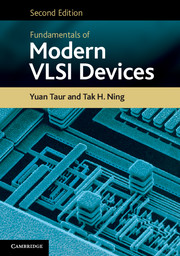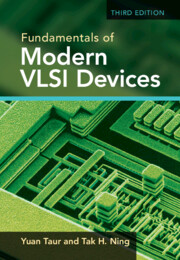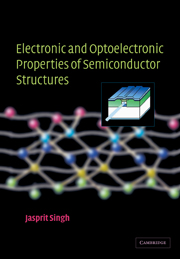Fundamentals of Modern VLSI Devices
Learn the basic properties and designs of modern VLSI devices, as well as the factors affecting performance, with this thoroughly updated second edition. The first edition has been widely adopted as a standard textbook in microelectronics in many major US universities and worldwide. The internationally renowned authors highlight the intricate interdependencies and subtle trade-offs between various practically important device parameters, and provide an in-depth discussion of device scaling and scaling limits of CMOS and bipolar devices. Equations and parameters provided are checked continuously against the reality of silicon data, making the book equally useful in practical transistor design and in the classroom. Every chapter has been updated to include the latest developments, such as MOSFET scale length theory, high-field transport model and SiGe-base bipolar devices.
- Two new chapters cover read and write operations of commonly used SRAM, DRAM and non-volatile memory arrays, in addition to silicon-on-insulator (SOI) devices
- 18 useful appendices discuss topics such as spatial variation of quasi-Fermi potentials and power gain of a two-port network
- New homework exercises at the end of every chapter engage students with real-life problems and test their understanding
Reviews & endorsements
'For the past several years, I've taught from Taur and Ning's book because it's best at connecting advanced device physics to real world device, circuit, and system technology. The second edition updates each chapter, adds new chapters on memory and SOI, doubles the number of appendices, and contains all new homework problems. The best book of its kind is now even better.' Mark Lundstrom, Purdue University
'I have taught a few VLSI device courses with the first edition as a textbook. Those were enjoyable experiences and the book was well received by students. Now the second edition comes with timely updates and two new chapters, which continue the tradition of emphasizing the design aspects of modern VLSI devices. I strongly recommend this book as a text or a reference in semiconductor device courses.' Byung-Gook Park, Seoul National University
'Fundamentals of Modern VLSI Devices, by Taur and Ning, has been an important reference text for our graduate semiconductor device physics course at the University of California, Berkeley for several years. It provides a well-written review of the operation of MOSFETs and BJTs. The new edition expands on this by introducing major new topics related to memories, silicon on insulator devices, and scale length and high field modeling as applied to MOSFETs. By including this material, this text is now positioned to be the primary text for typical graduate device physics courses, and will meet the needs of both students and instructors through its combination of detailed, well-written, and easy to follow descriptions of device operation, coupled with exercises and assignments for testing understanding of the relevant course material.' Vivek Subramanian, University of California, Berkeley
'This second edition of Fundamentals of Modern VLSI Devices builds on the tremendous success enjoyed by the original book. It provides well-organized and in-depth discussions on all relevant aspects of modern MOSFET and BJT devices, with an excellent balance of physics and mathematics. Every chapter is revised to reflect advances in VLSI devices in the last 10 years since the publication of the original book. Two new chapters on memory and silicon-on-insulator devices have been included along with nine additional appendixes. The problems at the end of each chapter are carefully designed and serve to help the readers better understand the key concepts.' Wei Lu, University of Michigan
Product details
No date availablePaperback
9781107635715
680 pages
246 × 173 × 31 mm
1.32kg
Table of Contents
- Physical constants and unit conversions
- List of symbols
- Preface to the second edition
- Preface to the first edition
- 1. Introduction
- 2. Basic device physics
- 3. MOSFET devices
- 4. CMOS device design
- 5. CMOS performance factors
- 6. Bipolar devices
- 7. Bipolar device design
- 8. Bipolar performance factors
- 9. Memory devices
- 10. Silicon-on-insulator devices
- Appendices:
- 1. CMOS process flow
- 2. Outline of a process for fabricating modern n-p-n bipolar transistors
- 3. Einstein relations
- 4. Spatial variation of quasi-Fermi potentials
- 5. Generation and recombination processes and space-charge-region current
- 6. Diffusion capacitance of a p-n diode
- 7. Image-force-induced barrier lowering
- 8. Electron-initiated and hole-initiated avalanche breakdown
- 9. An analytical solution for the short-channel effect in subthreshold
- 10. Generalized MOSFET scale length model
- 11. Drain current model of a ballistic MOSFET
- 12. Quantum-mechanical solution in weak inversion
- 13. Power gain of a two-port network
- 14. Unity-gain frequencies of a MOSFET transistor
- 15. Determination of emitter and base series resistances
- 16. Intrinsic-base resistance
- 17. Energy-band diagram of a Si-SiGe n-p diode
- 18. fr and fmax of a bipolar transistor
- References
- Index.






